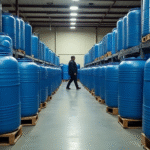Introduction to the Reform Initiative by PAN’s Ignacio Castellanos Amaya
Ignacio Castellanos Amaya, a representative from the Partido Acción Nacional (PAN), has introduced an amendment to the Integral Sustainable Rural Development Law. The proposed reform aims to promote training in agroecological practices among farmers, enhancing agricultural production in vulnerable municipalities prone to drought or flooding while reducing dependence on external inputs.
Nuevo León’s Agricultural Landscape
Nuevo León, a state in Mexico, boasts 44,191 units of agricultural and forestry production, covering 835,516 hectares. This includes:
- 28,097 active agricultural production units with 611,327 hectares of agricultural land
- 66 active forestry production units with 8,673 hectares of agricultural land
- 16,028 units with lands entirely at rest, covering 215,516 hectares of agricultural land
According to the 2022 Agricultural Census by INEGI, out of the 611,327 hectares of agricultural land in active agricultural production units, 502,783 hectares were sown. The rest was non-sown land due to factors like poor weather, lack of credit, illness, insufficient funds, or lack of support. Additionally, there were instances where no one sowed the land.
Vulnerability to Drought and Flooding
Nuevo León’s agricultural sector faces significant vulnerability to drought, particularly in northern and eastern municipalities like Anáhuac, Lampazos de Naranjo, Vallecillo, China, and Doctor Coss. The semi-arid climate and reliance on seasonal rainfall limit agricultural production. In the Monterrey metropolitan area, pressure on dams and aquifers poses risks during periods of low rainfall.
The Importance of Agroecology
Agroecology emerges as the integration of agronomy focused on agricultural production and ecology, oriented towards studying natural systems. Castellanos Amaya emphasized the necessity of transitioning to more sustainable practices, improving food production, and preserving natural resources in Mexico.
He highlighted two significant challenges: rural poverty and vulnerability, which are more pronounced than in urban areas, and the low coverage of extension and training services. This limitation hinders the adoption of new technologies and sustainable soil and water management.
Success Stories
Castellanos Amaya argued that agroecology training should become a broad public policy, similar to Brazil’s National Policy on Agroecology and Organic Production. This policy ensures funding, technical assistance, and public procurement.
Promoting farmer training in these methods is strategic for achieving sustainable rural development. It aims to increase productivity and profitability in rural communities, ensure food security and sovereignty, reduce social inequality, and preserve natural resources for future generations.
Key Questions and Answers
- What is agroecology? Agroecology integrates agronomy focused on agricultural production with ecological study of natural systems.
- Why is this reform necessary? The reform aims to enhance agricultural production in vulnerable municipalities, adapt to droughts and floods with minimal environmental impact, and reduce dependence on external inputs.
- What challenges does the transition to sustainable practices face? The main challenges are rural poverty and vulnerability, low coverage of extension and training services, limiting the adoption of new technologies and sustainable soil and water management.
- What are the benefits of promoting agroecology training? It aims to increase productivity and profitability in rural communities, ensure food security and sovereignty, reduce social inequality, and preserve natural resources for future generations.






